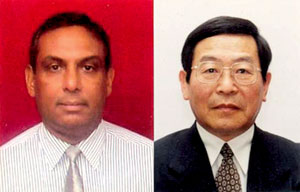Cement shortage due to increased Asian demand
by Surekha Galagoda
|

Marketing Director Cement, D. S. Walpola and Joint Managing
Director, Tokyo Cement Company (Lanka) Ltd., Kuni Yanagihara
|
The shortage of cement in Sri Lanka is due to the world demand
especially the increased demand from Asia, said Joint Managing Director
Tokyo Cement Company (Lanka) Ltd. Kuni Yanagihara.
He said that the demand from Asia especially from China and India has
increased due to the increase in construction activities in their
countries. A massive construction drive is under way due to the Olympics
to be held next year and the Expo exhibition to be held in 2010.
According to statistics the world cement production last year was 2.5
billion metric tons. Asia consumed 69% while the rest of the world
consumed 31%. of the Asian consumption, China consumed 47%, India 7%
while the rest of the Asian countries consumed 15%.
Yanagihara said that the world demand coupled with the demand in the
country from August to November created the cement shortage in the
country.
He said that usually during August-November prior to the rains there
is a construction boom in the country.
He said that Sri Lanka consumed 4.1 mln metric tons of cement last
year of which 75% is imported while the balance is manufactured locally.
He said that the growth in the cement industry in Sri Lanka is 12%.
Marketing Director Cement D. S. Walpola said that there are four
types of cement in Sri Lanka-the ordinary Portland cement, blended
cement, Portland limestone cement and masonry cement.
The Ordinary Portland Cement (OPC) consists of 100% cement and is
used for general construction and concreting and 70% of the global
cement requirement is OPC. The cement industry globally contributes to
6% of the global warming due to the emission of carbon dioxide in the
production process.
The cement companies are concentrating on the reduction of carbon
dioxide emissions and the solution for this problem was the introduction
of blended cement which contains pozzoolan a cementitious material such
as volcanic ash fly ash, or blast furnace slag. This cement is
recommended for application in marine structures and for structures in
marshy and coastal areas.
Portland Limestone cement is a diluted form of ordinary Portland
cement due to the addition of 15% limestone filler to cement clinker in
the grinding process. Masonry cement is used for brick work and
plastering for easy workability and is cost efficient.
Yanagihara said that Tokyo Cement believes in continuously improving
their efficiency product lines and logistics and therefore are
installing a vertical roller mill, the latest in cement grinding
technology from Messrs Kruppe Polysius of Germany. The total investment
on this plant and infrastructure is US$ 15 mln. This will increase the
company's total investment to US$ 97 mln.
In addition Tokyo Cement is the first in the cement industry to own
and operate a vessel to transport clinker. At present the company has
three vessels and are in the process of acquiring a fourth vessel, said
Yanagihara.
The Tokyo Cement Colombo terminal has also launched a converted and
customised vessel to further streamline the cement delivery to the
Colombo Port. The vessel is equipped with a state of the art cement
loading and unloading system.
The vessel can unload cement at the rate of 425 metric tons per hour
and load at 1,000 metric tons per hour. The total investment of the
vessel by the Tokyo Cement Group exceeds one billion rupees.
As one of the Company's CSR initiatives they are building a biomass
power plant with an investment of US$14 mln. The plant once completed
will have the capacity to generate 10 MW of eco friendly power which is
more than adequate to meet the requirement of the Tokyo Cement plant in
Trincomalee.
The fuel used in the bio mass plant are paddy husks and dried
glidiceria branches.
[email protected]
|
